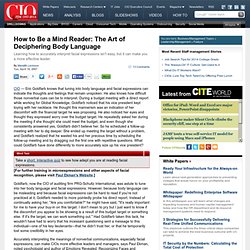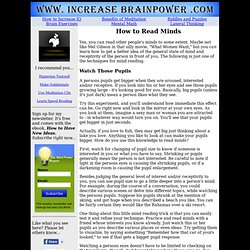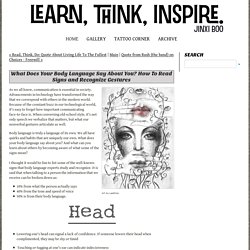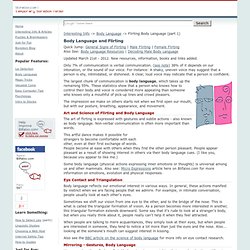

How to Be a Mind Reader: The Art of Deciphering Body Language CIO. CIO — Eric Goldfarb knows that tuning into body language and facial expressions can indicate the thoughts and feelings that remain unspoken.

He also knows how difficult those nonverbal cues can be to interpret. During a budget meeting with a direct report while working for Global Knowledge, Goldfarb noticed that his vice president kept toying with her necklace. He thought this mannerism was an indication of her discomfort with the financial target he was proposing. He also noticed her eyes and thought they expressed worry over the budget target. He repeatedly asked her during the meeting if she thought she could meet the budget, and even though she consistently answered yes, Goldfarb didn't believe her.
[For further training in microexpressions and other aspects of facial recognition, please visit Paul Ekman's Website.] Goldfarb, now the CIO of auditing firm PRG-Schultz International, was astute to tune into her body language and facial expressions. Continue Reading. Mind Reading. If a baby starts to cry several hours after drinking his last bottle, his mother knows precisely what he's feeling: He's hungry.

But suppose a woman's eyes brim with tears while she watches a DVD. Her husband sinks into the couch: What is she so upset about? She might tell him directly: "This movie is so tragic. It's all about a doomed romance. " That may be true. Quickly and unknowingly, he scours his mental files—on his wife's relationship history, on her reaction to the fight they had that morning, on the way she typically reacts to similar movies. Every day, whether we're pushing for a raise, wrestling with the kids over homework, or judging whether a friend really likes our latest redecorating spree, we're reading each other's minds.
Scientists Say Everyone Can Read Minds. Empathy allows us to feel the emotions of others, to identify and understand their feelings and motives and see things from their perspective.

How we generate empathy remains a subject of intense debate in cognitive science. Some scientists now believe they may have finally discovered its root. We're all essentially mind readers, they say. The idea has been slow to gain acceptance, but evidence is mounting. Mirror neurons In 1996, three neuroscientists were probing the brain of a macaque monkey when they stumbled across a curious cluster of cells in the premotor cortex, an area of the brain responsible for planning movements.
Because the cells reflected the actions that the monkey observed in others, the neuroscientists named them "mirror neurons. " Later experiments confirmed the existence of mirror neurons in humans and revealed another surprise. Since their discovery, mirror neurons have been implicated in a broad range of phenomena, including certain mental disorders. Theory theory. Read Minds. Yes, you can read other people's minds to some extent.

Maybe not like Mel Gibson in that silly movie, "What Women Want," but you can learn how to get a better idea of the general state of mind and receptivity of the person in front of you. The following is just one of the techniques for mind reading. Watch Those Pupils A persons pupils get bigger when they are aroused, interested and/or receptive. If you look into his or her eyes and see those pupils growing large - it's looking good for you. Try this experiment, and you'll understand how immediate this effect can be. Actually, if you love to fish, they may get big just thinking about a lake you love. What Does Your Body Language Say About You? How To Read Signs and Recognize Gestures - Jinxi Boo - Jinxi Boo. Art by LaetitziaAs we all know, communication is essential in society.

Advancements in technology have transformed the way that we correspond with others in the modern world. Body Language and Flirting - Blifaloo. Interesting Info -> Body Language -> Flirting Body Language (part 1) Quick Jump: General Signs of Flirting | Male Flirting | Female Flirting Also See: Body Language Resources | Decoding Male Body Language Updated March 21st - 2012.

New resources, information, books and links added. Only 7% of communication is verbal communication. (see note) 38% of it depends on our intonation, or the sound of our voice. The largest chunk of communication is body language, which takes up the remaining 55%. The impression we make on others starts not when we first open our mouth, but with our posture, breathing, appearance, and movement.
Art and Science of Flirting and Body Language The art of flirting is expressed with gestures and subtle actions - also known as body language. This artful dance makes it possible for strangers to become comfortable with each other, even at their first exchange of words. How to Read People: Detecting Lies. Have you ever wished that you could tell when someone is lying to you?
Whether you’re dealing with Mike the mechanic from the local repair shop, or watching one of our beloved politicians on prime time, learning how to ferret out deception is a deserving skill in a world very unlike Pleasantville. It is in this final post on How to Read People, that I go into detail about how you can detect lies. How to Read People – Series 1. Preparing to Read People 2. Human communication is an extremely complex exchange. There seems to be some limitation built into us whether by learning or by the design of our nervous systems, a limit that keeps our channel capacities in this general range – determined by George Miller author of The Magical Number Seven. Because of our apparent limitation in conscious processing, the average Joe can only detect lies with about 50% accuracy. It is important to note that this article deals mainly with the principles behind lie detection.